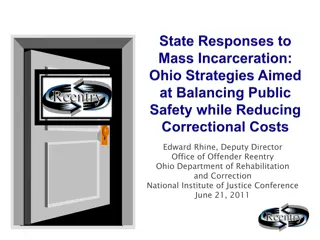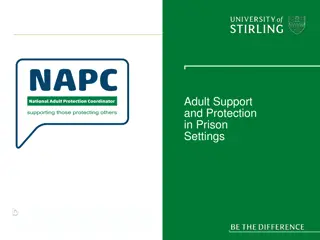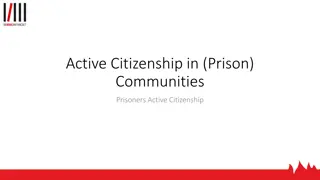
Prison System in Poland: Ensuring Human Rights and Rehabilitation
Discover the functioning of the Polish prison system through acts and regulations, focusing on the protection of personal liberty, humane treatment, and rehabilitation efforts. Learn about the tasks of the Prison Service in upholding the dignity and rights of individuals deprived of their liberty, as well as ensuring public safety and security.
Download Presentation

Please find below an Image/Link to download the presentation.
The content on the website is provided AS IS for your information and personal use only. It may not be sold, licensed, or shared on other websites without obtaining consent from the author. If you encounter any issues during the download, it is possible that the publisher has removed the file from their server.
You are allowed to download the files provided on this website for personal or commercial use, subject to the condition that they are used lawfully. All files are the property of their respective owners.
The content on the website is provided AS IS for your information and personal use only. It may not be sold, licensed, or shared on other websites without obtaining consent from the author.
E N D
Presentation Transcript
Budapest, 9-11.11.2015. POLISH POLISH PRISON PRISON SYSTEM SYSTEM
KONSTYTUTION OF POLAND KONSTYTUTION OF POLAND Art. 41. 1. Everyone shall have personal inviolability and personal liberty. Deprivation or restriction of liberty may occur only according to principles and procedures specified by statute. 4. Anyone who is deprived of liberty shall be treated in a humane manner. 5. Each unlawfully deprived of liberty shall have the right to compensation.
Act Act of 9 April 2010. of 9 April 2010. about about the Prison the Prison Service Service Art. 1. The Prison Service is uniformed and armed apolitical formation subordinated to the Ministry of Justice, which has its own organizational structure. Article 10.2. The Director-General is the superior of all officers.
The tasks of the Prison The tasks of the Prison Service Protection Protection- -Safety Safety- -Rehabilitation Service Rehabilitation The main tasks of the Prison Service include: conducting penitentiary and rehabilitation to persons sentenced to imprisonment, mainly by organizing the work of favoring the acquisition of professional qualifications, teaching, cultural and educational activities, activities in the field of physical culture and sport, and specialized therapeutic effects; execution of pre-trial detention in a manner that protects the proper conduct of criminal proceedings for a crime or a financial crime; to ensure that persons sentenced to imprisonment or in detention, as well as those against whom they are made of imprisonment and coercion resulting in the deprivation of liberty, respect their rights, especially humane living conditions, dignity, health and religious beliefs; humane treatment of persons deprived of their liberty;
The tasks of the Prison Service The tasks of the Prison Service Protection Protection- -Safety Safety- -Rehabilitation Rehabilitation To protect the public from offenders or prisoners fiscal offenses in prisons and detention centers; Providing in prisons and remand order and security; Cooperation with the relevant formations of other states and international organizations on the basis of international agreements.
Employees of the Prison Service Employees of the Prison Service 18 years of age and has full capacity to act and enjoys full civil rights; it guarantees properly execution of tasks; has not been convicted by final judgment for an intentional crime, or in respect of which no final judgment has been issued conditionally discontinuing criminal proceedings, and also not the subject of criminal proceedings against her; It is suitable for the position held education; a pledge of secrecy; (Act of 9 April 2010. Prison Service)
Employees of the Prison Service Employees of the Prison Service Officers and employees 29 004 Woman - 5 995 Officers 27 161 Women officers 4 890
Employees of the Prison Service Employees of the Prison Service Age structure Under 20 y.o. - 3 Age 21-25 - 879 Age 26-30 4 523 Age 31-35 7 317 Age 36-40 7 208 Age 41-45 4 392 Age 46-50 2 030 Age 51-55 667 Ag 56-60 128 Above 60 y.o. - 14
Employees Employees of education education structure of Prison Prison Service structure Service Higher MA -11 930 higher vocational education -3 522 secondary education 11 706 Vocational education 2 primary and lower secondary -1
The organizational structure of the Prison Service . Ministry of Justice The Central Board of Prison Service Central Training Centre of Prison Service in Kalisz Regional Inspectorates of the Prison Service 15 Prison Service Training Centre in Kule Prisons 88 Prison Service Training Centre in Popowo Detention centres 67 Prison Service Training Centre in Sucha
The legal bases of imprisonment? The legal bases of imprisonment? ACT ACT of 6 June 1997 of 6 June 1997. . Executive Penal Code Executive Penal Code Executive Penal Code is the basic legal act determining the proceedings against persons deprived of their liberty. It regulates, among others: Targets penalty and its individualization; rights and obligations of the convicted person; rewards, incentives, disciplinary action; the institution of conditional release; rules to help those relesed from prisons; public participation in the social rehabilitation of persons deprived of their liberty
Aims Aims of of imprisonment imprisonment Art. 67. 1. EPC The punishment of imprisonment is to inspire the convicts will cooperate in the development of its socially desirable attitudes, especially a sense of responsibility and the need to respect the law and thus refrain from returning to crime. To achieve the objective lead to individualized interaction within the framework of legally defined system of enforcement in different kinds and types of detention facilities. The impacts taken into account: working teaching cultural and educational activities and sports maintaining contacts with the family and the outside world therapeutic agents
Population of Prisoners Convicted, punished, detainees 74 184 woman-2 556 Convicted - 68 399 Woman convicted -2 243 Punished -1 116 Woman punished -73 Detainees - 4 669 Woman detainees -240 (Data: PS April 2015 r.)
Population of prisoners prisoners sentenced to life imprisonment 383 Woman with live sentence - 13 Dangerous prisoners - 158 Foreginers prisoners 523 Woman in that groups - 27
Types of prisons Closed-type Prison Semi-open Prison Open type Prison
Types of prisons prison for juveniles; prison for serving a sentence for the first time; prison for recidivists; prison for military priosoners;
Systems of Imprisonment Systems of Imprisonment The normal - convicted adults who do not give their consent to serve their sentences in the system of programmed impact; The programmed effects - convicted minors and adults who consent to participation in the creation of the program and participate in its implementation; Therapeutic system - designed for prisoners with mental disorders, including sex offenders, committed in connection with disorders of sexual preferences, mentally disabled and dependent on alcohol, narcotics or psychotropic medication and physically disabled prisoners.
Penitentiary work Work places Participation of convicts recruited for a fee in the total number of employees (25 300 prisoners) is 40% Work of prisoners employed for free in 2014 worth 66 700 000 z Education 20 prison schools with the education from primary school to post- secondary 3,500 convicts a year goes to prison schools or participate in vocational courses Educational classes and sports Contact with family and the outside world
Penitentiary work Therapy 70 rehabilitation centres: 22 centres for people with mental disorders or mental disabilities including 7 programs for perpetrators of sexual crimes committed in connection with disorders of sexual preference 15 centres for addicts of narcotic drugs or psychotropic 33 centres for addicted to alcohol
Electronic Monitoring System (EMS) Poland is the 13th country in Europe with EMS The system was built based on models from the UK 10000 places in EMS system From start in 2009 46882 persons used EMS






















